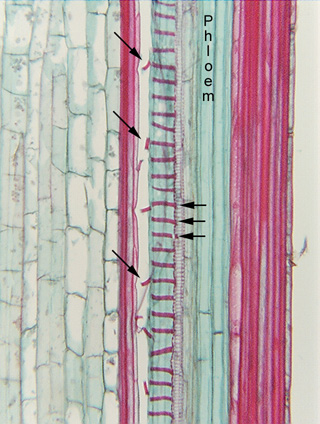 Fig.
7.2-1. Longitudinal section of corn stem (Zea
mays). This section cuts through a vascular bundle, with phloem on the
right, xylem on the left. The first conducting cells formed in the xylem were
vessel elements with annular
secondary walls (that is, their secondary walls were in the form of
several rings per cell; also called annular thickenings [notice this is
“annular” – ring-like, not “annual” = yearly]). After the vessel
elements completed their differentiation and died, the surrounding tissues
continued to expand, stretching the primary walls of the vessel elements, thus
pulling the rings farther apart. The rings in the center cell (three rings
indicated by horizontal arrows) were formed much closer together but have been
pulled apart. The vessel element just to the left became mature (and died)
earlier, so has been subjected to more stretching and its rings are very far
apart (three tilted arrows); the primary wall of this vessel element has
probably been torn, so the cell can no longer conduct water.
Fig.
7.2-1. Longitudinal section of corn stem (Zea
mays). This section cuts through a vascular bundle, with phloem on the
right, xylem on the left. The first conducting cells formed in the xylem were
vessel elements with annular
secondary walls (that is, their secondary walls were in the form of
several rings per cell; also called annular thickenings [notice this is
“annular” – ring-like, not “annual” = yearly]). After the vessel
elements completed their differentiation and died, the surrounding tissues
continued to expand, stretching the primary walls of the vessel elements, thus
pulling the rings farther apart. The rings in the center cell (three rings
indicated by horizontal arrows) were formed much closer together but have been
pulled apart. The vessel element just to the left became mature (and died)
earlier, so has been subjected to more stretching and its rings are very far
apart (three tilted arrows); the primary wall of this vessel element has
probably been torn, so the cell can no longer conduct water.